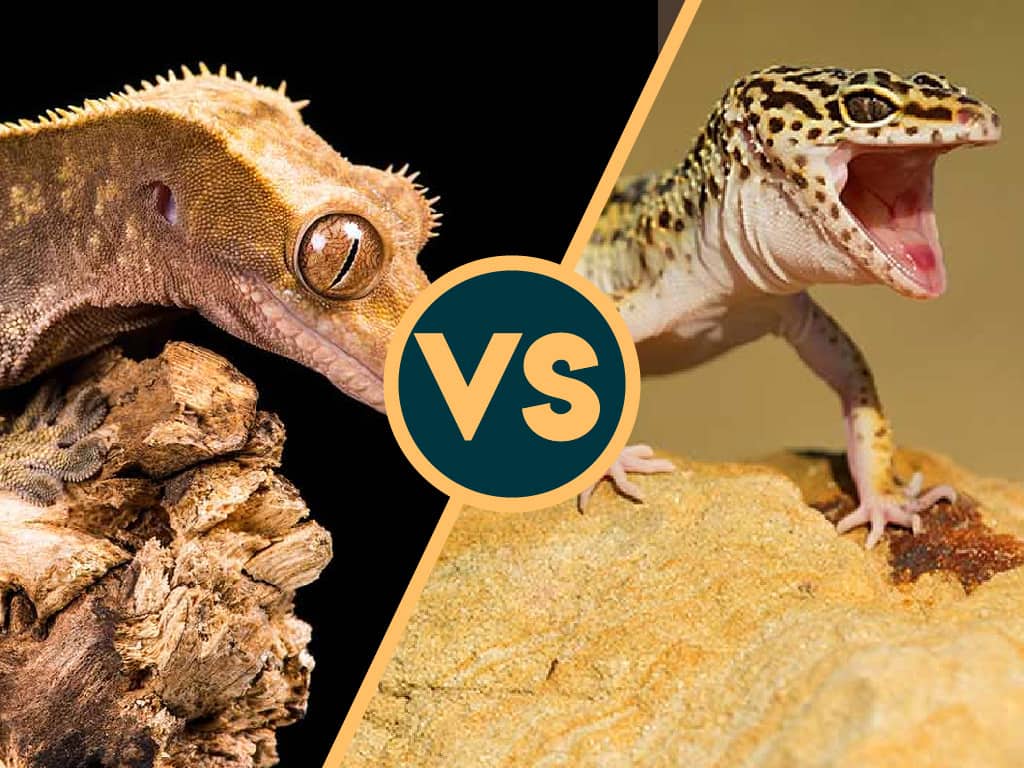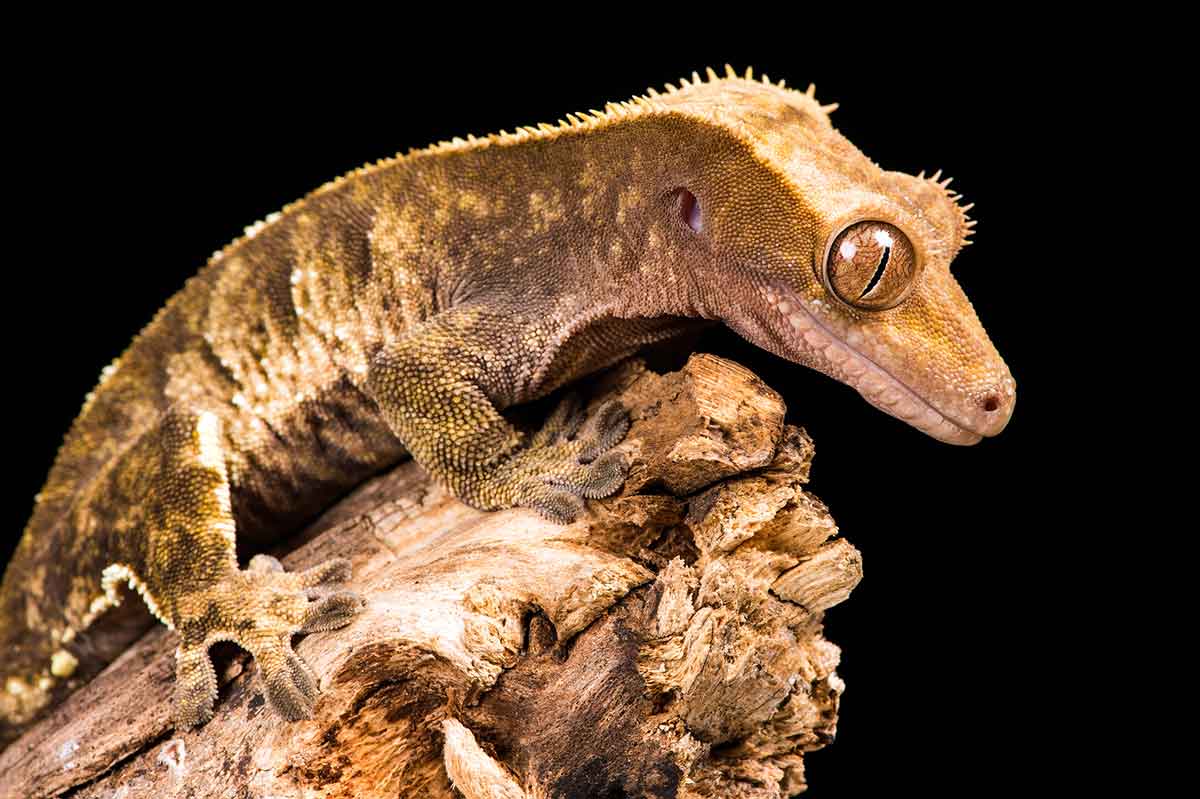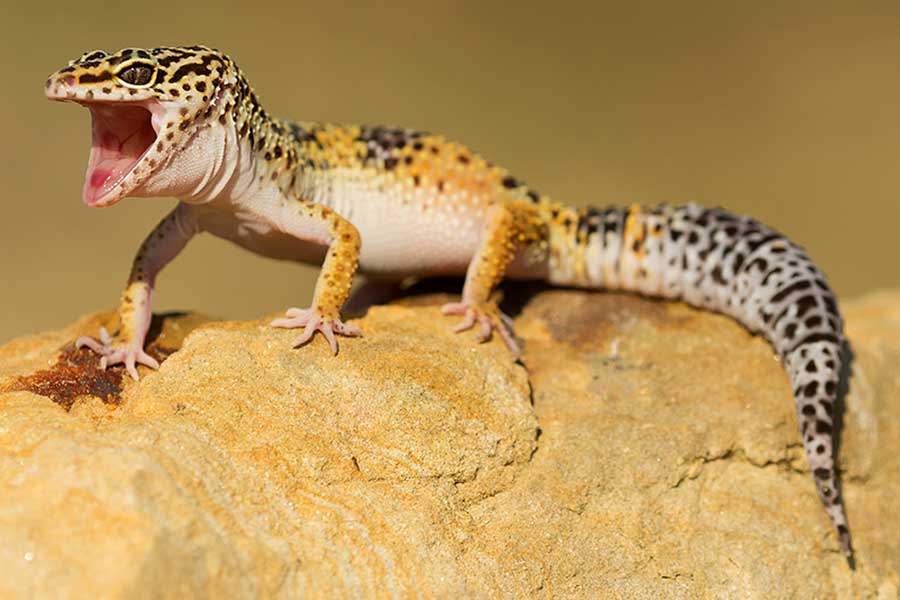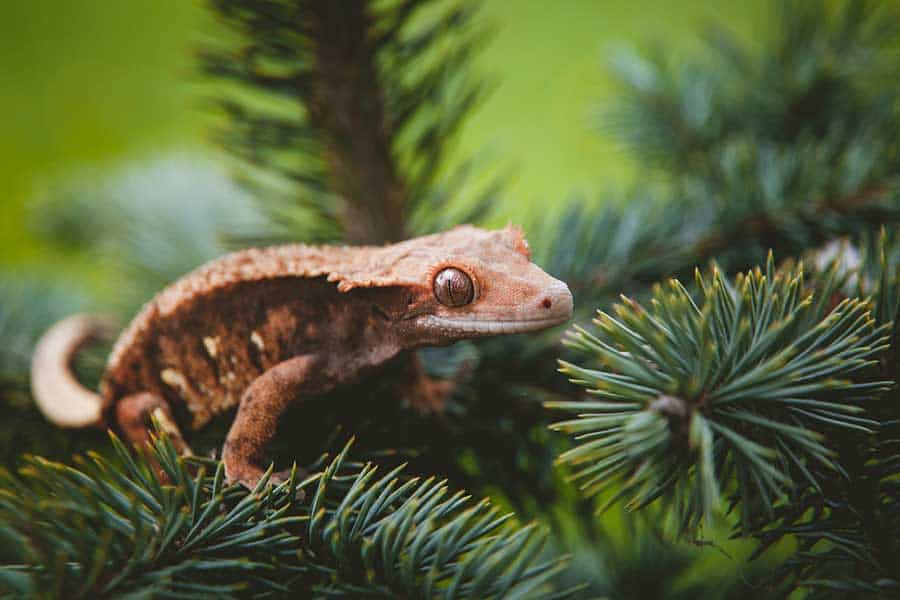
What is the difference between crested geckos vs leopard geckos?
Crested geckos and leopard geckos are both adored by the reptile community. They are spunky little animals with huge personalities. However, they have vastly different care requirements, appearances, and temperaments, which means they each suit different people’s lifestyles and preferences.
If you’re trying to decide between adopting a leopard gecko or a crested gecko, you need to make sure you are able to care for them properly and sufficiently meet their needs in captivity.
Read on to learn what the main differences are between crested geckos and leopard geckos so you can know which one best suits you, your lifestyle, and preferences!
Leopard Geckos vs Crested Geckos
The main differences between crested geckos vs leopard geckos are:
- Crested geckos are arboreal geckos, whereas leopard geckos are terrestrial geckos.
- Crested geckos are omnivorous and eat vegetation as well as insects, whereas leopard geckos are strict insectivores.
- Crested geckos need lots of foliage and a humid environment, whereas leopard geckos need a drier, more desert-like enclosure.
- Crested geckos drop their tail very easily and cannot grow it back, whereas leopard geckos do grow their tail back after they drop them.
- Crested geckos typically live between 15 and 20 years, whereas leopard geckos will usually live between 12 and 15 years.
Crested geckos and leopard geckos are vastly different lizards. They require different diets, different enclosure setups, and live for different amounts of time. Truthfully, there can be no clear, objective winner between the two, as although they are very different, neither lizard is “better” than the other. It will all come down to which you prefer and which fits in with your lifestyle the best.
Crested vs Leopard Geckos: Overview
Although they are both fairly small, docile lizards, this is where the crested gecko and leopard gecko’s similarities end. Let’s take a look at the overall differences between these two species to give you a better idea of which one might be a better choice for you personally.
Crested Gecko

Crested geckos are beautiful, wide-eyed little geckos that are shy by nature but do warm up to their handlers with consistent and careful handling. They are arboreal geckos and love hanging out in the dense foliage in their warm, humid enclosures. They have sticky pads on their feet that allow them to climb plants and other surfaces with ease.
One great thing about crested geckos is they can be fed a commercial, pre-packaged diet that has been crafted specifically for them and is readily available in pet shops and online. Although these jumpy little geckos drop their tail at the smallest inconvenience, it does not hurt them and they can survive well without it. Sadly, it does not grow back like other gecko species’ tails (including the leopard gecko, for example).
Leopard Gecko

Leopard geckos are spotted, smiling little balls of fun. They love interacting with their owners and actually enjoy being handled. They are terrestrial geckos with claws rather than sticky pads on their feet, and they enjoy scurrying around their desert-like enclosure at dawn and dusk when they are most active.
These vocal, chirpy little guys are strict insectivores, and feeding time is a great way to bond with your little leo while nourishing them and providing enrichment. Leopard geckos do drop their tails when they feel threatened; however, they are able to easily and painlessly grow them back in a couple of weeks.
Enclosure Setup
Knowing whether your gecko is arboreal or terrestrial in nature is very important. These geckos both need enclosures that are specifically designed to mimic their natural habitats in the wild.
This means arboreal geckos who spend most of their time in trees need an enclosure that is taller than it is wide or long (and has mostly vertical space), while terrestrial geckos who spend most of their time on the ground need an enclosure that is longer or wider than it is tall (and has mostly horizontal space).
Crested Gecko
Crested geckos are arboreal lizards. This means they spend most of their time climbing high up in the branches of trees and rarely come down to the forest floor. As you might imagine, their enclosures need to be set up to accommodate this and need more vertical space for climbing rather than horizontal space.
Crested geckos need plenty of perches in their enclosures that are covered in leaves. This also provides them with plenty of cover to hide in when they are feeling threatened or stressed out.
Cresties’ toes are specifically adapted for arboreal life and have little pads on the ends which help them ‘stick’ to surfaces like the glass walls of their enclosures!
Leopard Gecko
Leopard geckos are terrestrial animals. They do not venture into the trees and instead spend all of their time on the ground in the wild and in captivity! While they do not venture at great heights, they do still need some logs or rocks to climb up onto.
These surfaces provide them with vantage points, which makes them feel secure, as well as more places to run around on and enrich themselves. This means that, like crested geckos, their enclosures need to reflect their specific needs. In general, leopard geckos need enclosures that are longer than they are wide or tall.
Unlike crested geckos, leos’ toes are tipped with short claws, and their legs hold them up off the ground to protect their tender bellies from hot sand in the wild.
How to Decide
Neither gecko wins in the enclosure setup category, as both tall and long enclosures are roughly the same price and take up about the same amount of space. You need to decide on which kind of enclosure you would rather look at as well as how the space in your home is oriented. Do you have space for a 40 gallon enclosure that is tall or long? The answer to that question will tell you which gecko is yours!
Diet and Feeding
Understanding your gecko’s dietary requirements is very important before you purchase them. The quality of a gecko’s diet will determine how long they live, how big they grow, and ultimately how happy they will be.
Crested Gecko
Crested geckos are omnivores. This means they eat a mixture of plant material as well as insects. They need a balanced diet to maintain proper nutrition.

Notably, crested geckos in captivity can eat a prepackaged powdered diet that is a mixture of plant material and insect protein which is already balanced to be wholly nutritious. However, adding live insects to their routine diet is also important because it provides them with enrichment as well as quick, tasty nutrition boosts.
Check out our guide on what crested geckos eat to see a detailed breakdown of what you would need to feed your crested gecko as well as how often and what supplements you would need to get.
Leopard Gecko
Leopard geckos are strict insectivores. This means they only eat insects. Their diet cannot be supplemented like the crested gecko because their digestive systems are not designed to digest and absorb plant material.

Leopard geckos need a good supply of fresh, live feeder insects daily to stay healthy and happy.
Safe and nutritious feeder insects include:
- Crickets
- Dubia roaches
- Phoenix worms (also known as NutriGrubs and black soldier fly larvae)
- Hornworms
- Silkworms
- Mealworms
Remember to always steer clear of bioluminescent insects that glow, such as lightning bugs or glow worms, as they are extremely toxic to reptiles.
Check out our complete guide on what leopard geckos eat to see a full breakdown of leopard gecko’s diets as well as how often you need to feed them and what supplements need to be included in their diet.
Which Is Easier to Feed?
Both crested geckos and leopard geckos need to eat live insects to stay healthy. However, leopard geckos will eat far more insects than crested geckos.
Crested geckos get a steady supply of nutritionally balanced prepackaged meals that are readily available in pet shops as well as online, so this is a convenience for you as the owner.
Neither gecko wins this category because, although their diets are different, the amount of effort required from you and the overall cost of their food will be pretty much the same.
Humidity and Temperature
Crested geckos and leopard geckos come from vastly different parts of the world, which means their humidity and temperature requirements in their enclosures will be very different.
Proper enclosure conditions can mean life or death for geckos and most reptiles in general. With their enclosure properly heated and the right humidity settings, you are ensuring your gecko has a comfortable home, which means they have the space to grow big and strong and live for as long as possible.
Crested Gecko
Crested geckos are also known as New Caldonian geckos because they come from southern New Caledonia. This island nation is a very humid and warm place, which means crested geckos’ enclosures need to mimic these conditions as closely as possible.

Crested geckos need consistently high humidity levels of 70% to 80%. This is typically achieved through manual daily misting or by installing a misting system as well as a hygrometer.
The temperature of a crested gecko’s enclosure should sit at 75°F and should never peak above 80°F. It is important to install thermometers and hygrometers to keep a careful eye on the conditions in your gecko’s enclosure.
Leopard Gecko
Leopard geckos come from desert-like areas throughout Asia and the Middle East. This means they are used to very dry and very hot conditions. Fortunately, their bodies are built to withstand and thrive in these environments.
Because leopard geckos come from such an arid region, they require very little humidity except for when they are shedding. Therefore, the humidity in their enclosure should be between 30% and 40% at all times.
These geckos need a wide temperature range all the way from 90°F in their basking spot to 75°F to 80°F on the cool end of the enclosure. Keeping an eye on the temperature with thermometers is essential.
Climate Needs
Both geckos need to have a careful eye kept on their enclosures to maintain proper humidity levels. Too much humidity in the leopard gecko’s enclosure means they will develop respiratory illnesses, and too low humidity in a crested gecko’s enclosure means they will become dehydrated.
The winner will be which aesthetic you prefer or are comfortable maintaining. Do you want to have an enclosure that is very green and very wet or an enclosure that is very dry and hot? The answer to that question will tell you which gecko is best for you!
Tail Autotomy
Autotomy refers to “self-amputation” and is the scientific term for the ability of certain lizards break off their tail when they feel threatened in any way. The severed tail serves as a distraction for predators and makes it easy for them to scurry off to safety.
Some lizards have the ability to regrow their tails, and some do not.
Crested Gecko
Crested geckos are a bit skittish and are therefore notorious for dropping their tails at the slightest inconvenience. Unfortunately, crested geckos do not have the ability to regrow their tails. There are many experienced reptile owners who have never even seen a crested gecko with a tail.
When the crested gecko drops its tail, it does not cause it any harm if it is an adult. If the gecko is still developing and is a juvenile or subadult, then there could be a slight delay in their growth because their tails are fat reserves.
Crested geckos can still leap from branch to branch or from your hand to your face without their tails, no problem!
Leopard Gecko
Leopard geckos can also drop their tails if they feel threatened. However, unlike crested geckos, leopard geckos do grow their tails back within a couple of weeks!
Unfortunately, their tails will never look like the original. The patterning will be slightly different, and they will generally be a bit smaller or have a different shape.
Due to the fact that they regrow their tails, this can have an impact on their growth rate if they lose their tail when they are a juvenile or subadult and are still developing.
Leopard geckos store a lot of fat in their tails. If they drop their tails and then replace that fat store, it does take a lot of energy, and their overall growth may be stunted slightly. As their owner, you can help them by offering them extra food during this regrowth stage.
Regeneration Advantage
Leopard geckos would win this category simply because they can regrow their tails. However, if you do not mind a tailless lizard, then this should not discount the crested gecko from the race!
Life Expectancy
Knowing how long your new pet is going to live is very important because you need to know how long your commitment to them will be. It is very irresponsible to buy a lizard and assume it is only going to live for a couple of years and then you can move on to a new pet.
If you are looking for a short-term lizard commitment, then look at getting a green anole or something similar that only lives for a few short years.
Crested Gecko
Crested geckos live on average between 12 and 15 years. This is a pretty average lifespan for lizards of their size.
Although their lifespans are mostly genetically determined, there are still some things you can do to help them live as long as possible! For example, make sure your gecko gets proper nutrition from their diet, provide them with a well-maintained and carefully monitored enclosure, and provide them with a whole bunch of love, patience, and care when handling them.
Leopard Gecko
Leopard geckos live on average between 15 and 20 years! This is quite long for such a small lizard. This means that you could purchase a leopard gecko when you are a teenager, and it will probably live long enough for your children to enjoy a large part of its life, too!
Like crested geckos, leopard geckos’ lifespans are mostly genetically determined. However, there are a couple of factors that can prevent them from reaching their maximum potential. For example, improper nutrition, a lack of
Longevity Advantage
Leopard geckos win the lifespan category simply because they live slightly longer than crested geckos.
Deciding Between Leopard Geckos vs Crested Geckos
Both geckos are excellent pets with different care requirements, but neither is significantly harder or easier to care for. This means your choice will ultimately come down to your preferences. Let’s recap these lizards’ biggest differences.
When it comes to the enclosure size and setup, it is up to you whether you have the space for and want an enclosure that has either more vertical or more horizontal space.
Both geckos eat insects, but crested geckos can also eat a prepackaged diet to maintain proper nutrition. Leopard geckos require more live insects in their diet.
As far as temperature and humidity requirements go, it all depends on whether you want to maintain a humid and warm habitat or a hot and dry one.
Leopard geckos do regrow their tails, but constantly regrowing a tail can impact their overall health. However, crested geckos get on just fine without their tails if they drop them.
All things considered, the only distinct advantage the leopard gecko has is that it has a slightly longer average lifespan than the crested gecko.
FAQs on Leopard Geckos and Crested Geckos
Can I house a crested gecko and leopard gecko in the same enclosure?
Crested geckos and leopard geckos are two very different species of gecko. You should not house different species of lizard in the same enclosure. The two geckos have vastly different enclosure requirements and would cause severe stress to each other.
Can I keep multiple crested geckos in the same enclosure?
Crested geckos are solitary animals and do not do well with others in their enclosure. Male geckos are especially territorial and aggressive towards one another. However, if you increase the size of the enclosure by at least 10 gallons per gecko, then you could house two female crested geckos together or, alternatively, one male and one female.
You’ll also need to make sure there are multiple food ledges, places to drink water, and hiding spots to prevent the geckos competing for resources.
Can I keep multiple leopard geckos in the same enclosure?
The same answer that applies to crested geckos also applies to leopard geckos. Leos are very territorial and will fight and bully each other if they feel threatened or if there are not enough resources to go around.
A Final Word
Crested geckos and leopard geckos both make excellent pets to experienced reptile owners as well as first-timers! They are relatively simple to take care of once you have all of their enclosure setup requirements and dietary needs covered.
Both of these adorable geckos have simple diets and always love a good cuddle. They are also very interesting to watch on their own in their enclosures.
Now that you are armed with the major differences between the two types of geckos, you can make a more informed decision about which fits in with your life the best!

